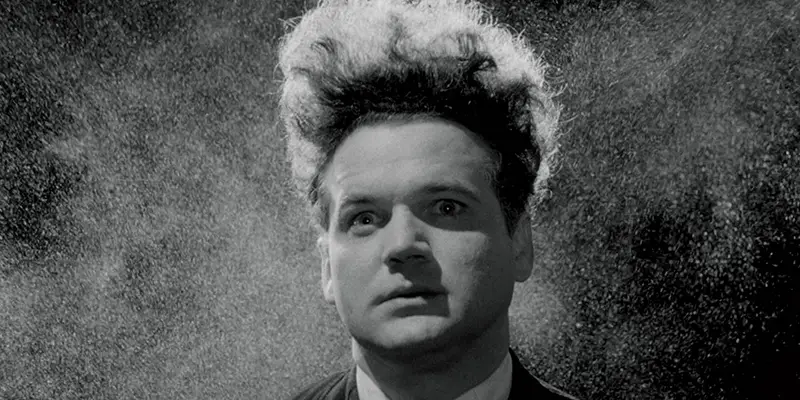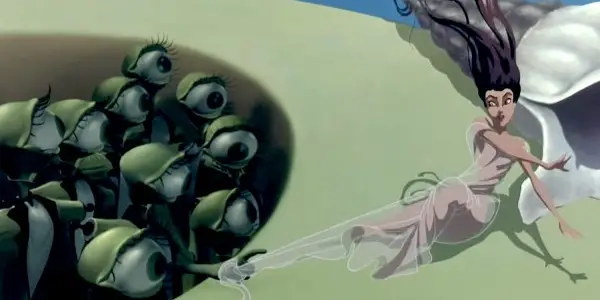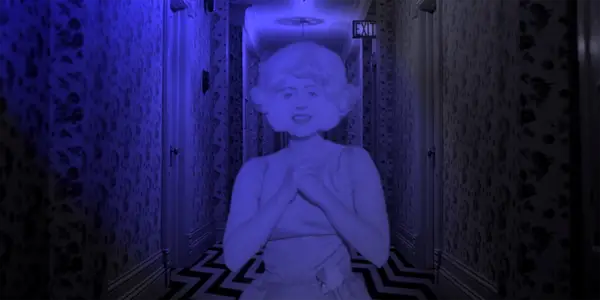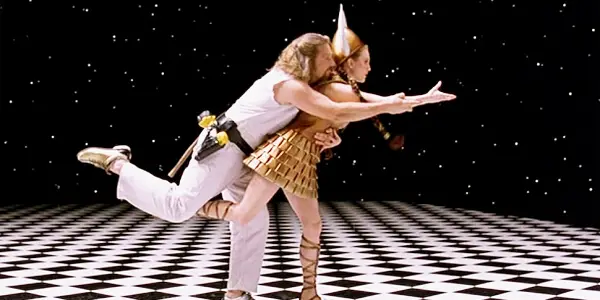Surrealist Cinema: 100 Years Of Psychedelia

Rachael Sampson is a Northern screenwriter and critic based in…
There is one movement cinephiles can thank for heroin addicts sinking into carpets and rose petals exploding from cheerleader’s chests: Surrealism. Not only has the movement influenced some of the most iconic films to date like Trainspotting and American Beauty, throughout the last century surrealism has completely turned cinema on its head; creating a new wave of film that drags reality into the world of insanity.
The power of surrealism in cinema has proved to be so resilient and well-received over the last 100 years that, through its depictions of psychedelic, dream-like realities, audiences have been able to make strong connections to these bizarre images and make sense of humanity. The mind does not always work as a stream of coherent thoughts; the founder of the movement André Breton demonstrated to the world that art should not be any different.
Surrealism does not restrict itself with boundaries in cinema. However, one question arises when looking at this style of film from its birth to modern day: has surrealism gradually become diluted in 21st century cinema? It is difficult to identify a variety of films as sought-after and shocking as the motion picture which set the bar for outlandish cinema in the first place: Un Chien Andalou.
Slicing Up Eyeballs
The Spanish short Un Chien Andalou (An Andalusian Dog) is an iconic and pivotal motion picture which not only revolutionised cinema for abstract filmmakers and audiences, but also injected brand new insights and ideologies into European culture socially and politically. Artist Salvador Dalí and filmmaker Luis Buñuel teamed up in 1929 to execute the world’s most unforgettable surrealist movie.

The beauty of this film is that it does not follow a generic narrative pattern; in fact the film does not follow any kind of linear narrative whatsoever. It has no specific plot and is rather disjointed and disarrayed as it jumps from drastically different time frames. One may question how a film which can be described as “disjointed” and “disarrayed” can simultaneously be labelled as one of the best classic films of all time, and the answer is this: when it comes down to surrealism, there is no fixed answer, meaning that every single person who watches this 1929 short film will likely take away something drastically different from another viewer.
Besides the dream-like/nonsensical narrative arrangement within Un Chien Andalou, one of the biggest factors for the movie’s success was the shocking imagery it presented. Aside from the shots of the creepy heavy-handed antagonist (played by Buñuel himself) and flies that crawl out of a hole in his hand, what strikes audiences most is the shot within the first minute of the film: a razor being dragged across the iris of a woman’s eye. This image was rather daring and controversial for its time, however it is that bold move from Dalí and Buñuel which allowed it to revolutionise cinema and be responsible for influencing a variety of other works not just in the cinematic industry, but in music, art, literature, and theatre.
When Dalí Met Disney
Dalí and Buñuel were commissioned to make another film due to the success of Un Chien Andalou, called L’Age d’Or, released in 1930. This film marked the split in friendship and working relationship between the two. More of Dalí’s surrealist creations can be seen in Alfred Hitchc*ck’s Spellbound (1945), where he designed the ominous dream sequence which also features an array of eyes – clearly one of his trademarks.

In 1946, Dalí collaborated with Walt Disney and made the surrealist short Destino – which was not completed until 2003 (completely posthumously), by Dominique Monfery, a Disney animator known for his animation work on Disney’s Hercules and Tarzan. However, because Dalí ‘s work was falling into popular mainstream culture (now globally – working with one of the biggest entertainment conglomerates to date), it indicates that there was a rapidly growing admiration for this style of unconventional and risqué artistry.
The short creates a menacing depiction of nostalgia as it reminds audiences who have been brought up on Disney movies of their childhood, with the iconic operatic music paired with the stereotypical princess with the big dress, long hair and completely unbalanced waist. However, the friendly PG-stylised picture transforms into a dark world of Dalí, where once more we see the eyes and insects crawl from the palm of a hand. This collaboration twists the generic childhood fantasies into obscure and confusing dreams, once again lacking a linear narrative. This darker and rather disconnected interpretation of the stereotypical Disney world ironically makes it one of the most relatable Disney films out there.
Surrealism and Horror
After seeing Dalí delve into mainstream film, many other filmmakers inspired by his portrayals began to create their own warped worlds. In 1967 a young David Lynch released his first short film project (Six Men Getting Sick) in which it depicts the repeating of people vomiting with their heads on fire projected on to a special sculptured screen, featuring twisted three-dimensional faces in various states of puking.
The film contains illustrations that move via stop motion, and it was not the last surrealist film made by Lynch. One of his most iconic films Eraserhead dives even further into a surrealist nightmare with a tale of male paranoia, and is viewed as a milestone in the independent filmmaking industry.

During this time surrealism was in full force, and with the twisted horror Suspiria being released around the same time (Dario Argento’s cult classic), it became clear that a pattern was forming in cinema. In the 1970s-’80s surrealism evolved into a sub-genre of horror. With films like Eraserhead, Suspiria, A Nightmare on Elm Street and Beetlejuice, the art movement was used to shock and horrify audiences through a sense of fear. It evolved from Dalí’s initial enigmatic films, where audiences were unclear of a definitive explanation. It could be said that surrealism was becoming rationalised by using it in horror films, as putting it in that category justified its eccentricity.
Dreams and Drugs
Aside from horror, another correlation appeared in surrealist cinema as the movement reached the ’90s: drugs. Surreal scenes are heavily used in films such as Fear and Loathing in Las Vegas, Romeo + Juliet, Trainspotting, Requiem for a Dream, and more as they all include and/or primarily focus on psychedelic visions, thus portraying them in an unearthly fashion.
Due to surrealism being used to interpret weird and wonderful trips, it began to fall into another genre – (dark) comedy. A perfect example of this would be in the 1998 Coen Brother’s film The Big Lebowski, where the protagonist’s drink is drugged, leading the Dude (Jeff Bridges) to have a strange and comedic dream sequence; he is in a fantasy bowling world pretending to be the ball, sliding through women’s legs.

As themes of drugs are giving the audience explanation for the surreal imagery, it suggests that pure surrealist film is on the decline (realms where justification is not warranted). Once again it seems as if a genre or theme, (in this case drugs) are being used to give clarification and rationalise the strange images by painting them as hallucinations due to narcotics. If modern day surrealist film was to be compared to the works of Dalí, it is plausible to infer that vindicating the action may take something away from the beauty of the surreal.
Conclusion
In the 21st century, surrealism has appeared to shy away from mainstream film and is no longer seen at the same status as it was in the ’90s. David Lynch is still creating his surrealist masterpieces with Inland Empire and Mulholland Drive, and even dystopian Eternal Sunshine of the Spotless Mind was well-received, however it seems that recently, surrealism is seen more so in the indie and short film industry.
Surrealism has been watered down with explanations in mainstream film, and specific scenes are only included where one could see the surreal being fitting and plausible in terms of realism, i.e. in a horror, dream or state of psychedelia. It is as if there is a need to feed the audience with rationale constantly, and the films which are more avant-garde have taken a back seat in recent times. The outlandish and unorthodox world of surrealism was heightened in the mid-20th century, and with the death of Dalí – the father of surrealism – it looks as if his bold and daring depictions of dead deer on pianos and massacred eyeballs are yet to be challenged.
Other surrealist films: A Clockwork Orange, The Shining, 2001: A Space Odyssey, Being John Malkovich, The Seashell and the Clergyman, Enter The Void, The Act of Killing, The Taste of Tea, Pan’s Labyrinth, Bronson, Brazil, Groundhog Day, Paprika, Monty Python & The Holy Grail
What is your favourite surrealist film? Share your thoughts and comments!
Does content like this matter to you?
Become a Member and support film journalism. Unlock access to all of Film Inquiry`s great articles. Join a community of like-minded readers who are passionate about cinema - get access to our private members Network, give back to independent filmmakers, and more.
Rachael Sampson is a Northern screenwriter and critic based in London. Her latest film is currently in post production and she has 2 shorts cooking in the oven. Rachael is also a published short story author and theatre maker. She often finds herself daydreaming about Andrea Arnold's filmography and firmly believes that Inglourious Basterds is the greatest movie ever made.













